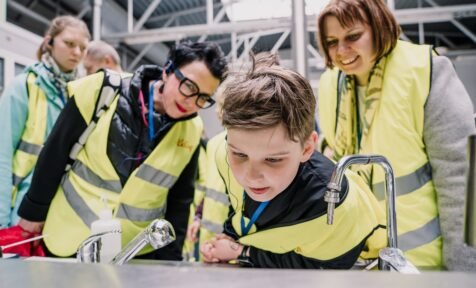When schools in Estonia had to change to distance learning again, this small school was ready. Learn what distance learning tips and decisions helped a teacher and mother of three to jumpstart learning in a way that could set an example. “I know what many parents are facing with their workload having soared, but it does not have to be this complicated”, says Gerly Lehtmets, a teacher from a small school in Imavere, Estonia, who is glad to share her tips and experience.
I work as an English teacher, and this year I am also striving to complete my studies for the master’s degree. My husband, who works in IT, also teaches physics in the local school. Lenna, our eldest (8), is in the second grade this year. Her younger sisters go to kindergarten but are also currently at home. My mother, who is also a teacher, is another member of our household. You can guess how things are run in a house with five rooms and six people, of whom 3 are teachers, 1 is a student, and 2 are little mischief-makers… Still, I dare say we have been doing quite well.
The school and the home working together is the key to success
There is a rule in place in our school that 50% of lessons with each form must be online, and the school day follows a lesson timetable, including online lessons as well. Feedback must be given and if anyone has not been seen for a while, or their performance worsens, this must be discussed immediately. For things to work out, our school decided to create school-based e-mail addresses for all the students and use the MS Teams as the common platform.
See also:
What helped Estonian schools successfully handle the corona crisis?
2nd-grade students have about four webinar-format lessons per day, and there is an afterschool group for those who need it. In her room, Lenna is singing ‘Happy birthday’ to her classmate. Four of the five lessons today are online sessions, including PE. After school hours, she can join the afterschool group through MS Teams.
To take part in the class, she has a computer with a web camera and earphones. Had the family needed it, the equipment could have been borrowed from the school. Schools in Estonia have been promoting this option, and families have been using it. In some cases, teachers have been providing aids when they see that a student’s microphone is not working, or background noise is disrupting the session.
My husband and I have taught Lenna how to log in to the necessary environments and helped her save bookmarks in the browser. And of course, we sometimes ask her how things are going at school. If there are any technical problems, we help her solve them and inform the teacher why our kid has stayed away from an online lesson or did not do her homework if that is the case.
Principle of our school: no extra load for parents
It was already last year that we started encouraging our daughter’s independence, teaching her that she would have to try and cope with schoolwork on her own, and we would help if necessary. But we also made it clear we would be able to help only outside of our working hours. There have been times when Lenna had to wait for such a moment for a while, and she sometimes feared she would not be able to submit projects in time. We taught her that she had to contact the teacher and explain what was going on in that case. Teachers need to know that students are doing the schoolwork and have not just dropped out. Giving an assignment late is OK if it does not become a habit.
Teachers are generally aware that parents cannot sit next to their children throughout the school day, so our school’s principle is to teach the student how to do and submit an assignment without dumping this workload on the parents. If a student does not understand what to do, how to do it and how to submit an assignment, they have been instructed to ask for help and are assured that teachers are always available through Teams during their work hours.
See also:
Estonia offers its digital education solutions for free to support other countries
It is vital to stay in touch
What we are trying to achieve is that school feels as ‘normal’ as possible. Every Wednesday, we hold a school assembly to provide information and share impressions about the previous school week at the beginning of the ‘homeroom session’ of the form teacher.
The key to our success lies in simple things. We are using MS Teams as the schoolwork environment and save all lessons in the students’ calendars. Students from the first grade on have been taught how to join a lesson, and this works.
We stick to the schedule, and all the students know when and what they are expected to do.
We give grades and record absences so that the parents can overview the child’s progress if they want to. We are making a lot of effort to make learning and teaching as stress-free as possible for everyone involved.
Every week, we hand-around food aid packages assembled so that even first-graders could have a meal independently. I dare say parents are happy with us. As a parent, I’m pretty satisfied.
What is the secret behind our school’s success?
-
All the staff and students have had Office accounts since the first wave of the coronavirus pandemic.
-
Anyone who needs a laptop computer and headphones can borrow these from the school. All the laptops the school has have been lent out. We have also managed to obtain more laptops thanks to the private initiative ‘A computer for every schoolchild’.
-
Schoolwork is organised remotely by the schedule which has only minor changes compared with the usual learning.
-
At least 50% of the lessons take place online, using Teams, and they are scheduled through the students’ calendars.
-
Teachers must provide feedback to every student at least once a week.
-
We keep up the team spirit by holding a weekly school assembly in Teams on Wednesdays, with most students and teachers taking part.
-
Students who need special support and enhanced support can come to school for classroom sessions.
-
The school orders and hands out weekly packages of prepared meals to all the students who study remotely.
-
There is a routine in place: online lessons, assembly sessions and meetings are held at the same time every week.
-
The teachers’ motivation is boosted through weekly online meetings, and they also have an option of working from the school and having a hot meal for lunch there.
-
The students can take part in extracurricular activities online, too (the spring photography contest, hobby groups, etc.).
A selection of distance learning tools
-
Pen tablet: I display an assignment or worksheet on the screen and write there so my students can see the correct answer in addition to hearing it (a very useful tool for those who need to write formulas, music score and other types of texts that are not so easily typed up).
-
Openboard: a whiteboard application to be used with the pen tablet or individually. I can create separate sheets that are saved automatically, so I can use the same board for several groups if necessary.
-
Web camera: it is essential for the student to see the teacher at least for a while, and it is equally important for the teacher to see the students because that prevents emotional fatigue, which tends to creep up when you talk for hours, but no-one replies. In addition to the built-in camera, I prefer using a separate one with a high-quality microphone to point the camera to the board, for example, and keep talking when I am next to the board. This is especially useful for hybrid learning when some of the students are at home, but some have come to school, it ensures everyone can hear everything, and the teacher does not have to repeat what has been said.
-
Document camera: I download the study aid and can show it to the students right away without scanning, which is not always available.
-
Vocaroo.com: an online voice recorder that allows the students to submit their oral assignments without signing in or downloading anything. The teacher does not have to download audio files either; they can click on the link and listen to the student’s answer.
-
Teachermade.com: an environment for generating e-worksheets. You upload a text document, PDF or image file, add various types of assignments and share it with students using Google Classroom or a link. The system can even automatically check certain assignment types, which allows you to save time doing it.
-
OPIQ – digital learning materials
-
Gamification with the help of Kahoot
-
Activities by Move Lab
The article is a translation from the article originally published on the webpage of Pere ja Kodu
Related
- New school year 2021, new challenges
- Survey: distance learning from children’s perspective
- What are Estonian schools doing differently during the second wave?
- How to support the mental health of young people?
- Developing independent learning skills in students
- How sport education in Estonia coped with Covid-19?





